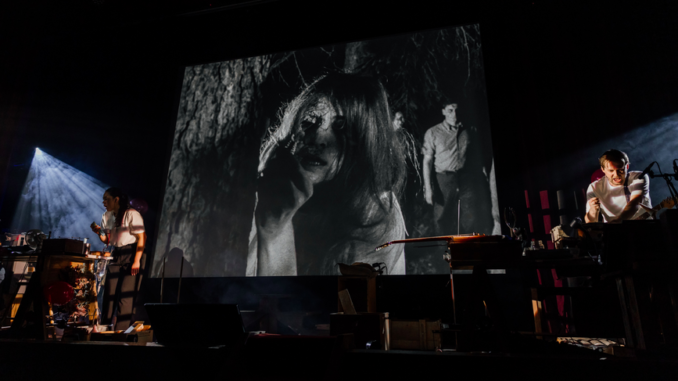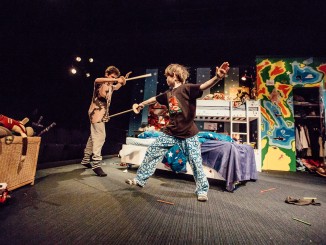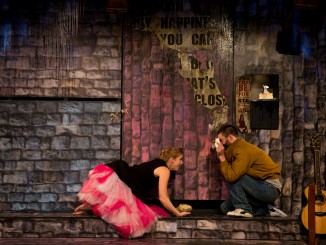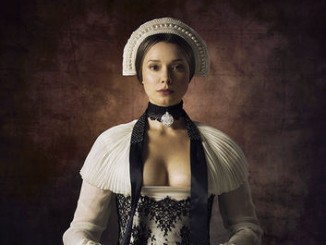
[Breathing New Life]
Silo Theatre Company’s first production after their almost year-long hiatus is one that blends cinema and theatre. It exposes the process of film-making, particularly that of foley and score which often go unnoticed by viewers, meant to provide realism and atmosphere that affect the audience mostly subconsciously. George A. Romero’s 1968 Night of the Living Dead is here pumped full of adrenaline and epically reanimated.
I hadn’t seen the film before but I was aware of its iconic cult status as the first zombie movie. This was no barrier to enjoyment, and many other audience members were also seeing it for the first time. The experience is rich, whether you know nothing about the film’s plot or whether you’re a Romero mega-fan.
Our attention is often split between the movie on-screen and the two performers – Jack Buchanan and Isla Mayo (who inhabit the sides of the stage behind two desks filled with musical instruments and an assortment of objects). Though I soon settled into mainly watching the screen, I was often drawn, sometimes very deliberately, to the live performance.
Live Live Cinema, created by Leon Radojkovic, is a Frankenstein-like hybrid of form. The dubbing of dialogue (with one notable exception that I’ll get to later), the crisp and elevated score, and the entrancing live foley all seem to make the film pop out of the screen, like a living thing. It is simultaneously immersive (enriching our experience of the film) and abstracting, pulling us into the here and now, the electricity and theatricality of live performance.
Rachel Marlow’s lighting mostly takes a back seat (to be expected) except for a few moments where it jumps out at us – mimicking the experience of the characters in the film, once again pulling it from the bounds of the screen and into the Hollywood Theatre.
Buchanan and Mayo expertly navigate what is essentially a meticulously choreographed dance – voicing multiple characters (sometimes in the same breath) while weaving in and out of foley production, musical performance, and fixed physical movements.
Mayo uses additional breath work to bring a depth to Barbara that elevates Judith O’Dea’s original performance (having gone back to compare), though the dubbing also serves to highlight the humour (to our modern sensibilities, at least) of this helpless damsel character.
Indeed, there is something about hearing these voices, complete with their old-style filmic way of speaking, recreated (with remarkable accuracy) in real time, before our very eyes, that brings out the more humourous aspects of the film. The rambling, catatonic Barbara; the bickering husband and wife; the scientists admitting they don’t know what’s going on, and the military man trying to shut them up; even the zombies (or ‘ghouls’) themselves with their slow stumbling and classic groans are heightened by Buchanan and Mayo’s reproduction. There is something about this film, at least viewed by modern audiences, that walks a fine line between horror and comedy. “Horror and comedy paradoxically co-exist together quite comfortably,” says Radojkovic in the program’s interview with academic Erin Harrington.
Radojkovic’s foley design, down to the choice of items (such as a clapper for gunshots), adds depth and realism to the film while managing to preserve the strange, almost campy, surreality of this late-60s low-budget flick.
There is one character whose original voice is used, down to the poor sound quality – that of Ben, the only black character in an all-white cast, played by Duane Jones. It is jarring to notice and, though I did become used to it, it remains a stark deviation from the show’s format – a clear choice on the part of directors Sophie Roberts and Sam Sneddon. Even after the film’s tragic ending, I found myself asking, why? It might have been seen as inappropriate for Buchanan to voice him but, in that case, why not just hire an actor of colour?
The role of Ben was initially written for a white actor. By casting Jones in this heroic role (controversial for 1968), Romero was, intentionally or not, adding racial politics to his already political film. Audiences at the time could not help but relate it to the contemporary struggle for Black Civil Rights and the assassination of Martin Luther King Jr. Watching today, Ben’s blackness stands out against the all-white ensemble, implicitly othering him. SPOILERS INCOMING: Ben’s death at the hands of militant civilians (mistaking him for a zombie) speaks to a failure of society at large to recognize the humanity of black folks.
Perhaps preserving his dialogue was to emphasise Ben’s ‘otherness’, contrasting him further with the other characters. It might’ve also been to preserve the seriousness and tragedy of his character. There is something inherently silly about watching actors dub the characters’ voices. Jones’ performance is perhaps the most grounded, so it seems sensible to let it speak for itself, allowing us to fully identify with him and connect to the stakes of the film.
Beyond that, this decision traps Ben within the world of the film, heightening the dark sense of inevitability that surrounds his (albeit sudden) death. The images of his body burning as the credits roll evoke state-sanctioned violence (the public at the time would’ve been all too familiar with the same style of images coming out of Vietnam). The world he is trapped in is a truly dangerous one for him and this is taken seriously, while the other characters pop out of the screen courtesy of the performers, almost becoming caricatures.
Today we are all-too familiar with the zombie-movie tropes pioneered by Romero. For example, when it’s mentioned that the daughter of the married couple has been bitten, we know she will turn into a zombie and likely consume her parents. But these creatures were new at the time – a startling image of average people (and, eventually, those closest to us) turned into monsters, slowly growing in number and appearing en masse with little explanation.
The film has been interpreted as a response to the Vietnam War, and critiques American society – the rabid consumerism promoted by capitalism is gruesomely turned into cannibalism; the mindless and indiscriminate violence of the zombies mirrors the horrors of the Vietnam War, and the heavy use of news broadcasts (the way the average American engaged with the war) supports this reading. Almost no one is beyond reproach – the state fails to protect its citizens or provide satisfying explanations, the nuclear family falls apart, and those supposedly fighting for freedom kill the film’s only true source of heroism.
But what relevance does this nihilistic portrayal of America in the ‘60s have to present day Aotearoa? Zombies, of course, have proliferated on our screens since this initial depiction, and are easy creatures to project a myriad of fears onto – the fear of mindless conformity, of mass senseless violence, of the spread of disease. The Covid-19 Pandemic brought out the best and worst of humanity, highlighting the dangers of misinformation and groupthink, and emphasizing economic disparities. We could read Ben as displaying the qualities that helped us weather the storm: resourcefulness, calm rationality, and compassion. In this reading, his death takes on a disturbing meaning. Indeed, the true darkness of the film might lie in the thought that our society has not changed. We are still suffering at the hands of capitalism, pushed towards mindless consumption; people of colour are still the targets of state and civilian violence; senseless wars still rage around the world.
Silo’s Live Live Cinema brings this classic film’s potent themes to a new audience while heightening its absurd and gruesome horror with stunning sound design. It is a love-letter to the horror genre, as well as to foley artists and the power of sound to encode meaning. It is a fun and innovative concept that unites the mediums of cinema and theatre; it playfully exists in both and neither. It is full of delicious contradictions – like the zombies themselves, caught between life and death.
Night of the Living Dead plays The Hollywood, Avondale 2nd-12th November 2023




Leave a Reply